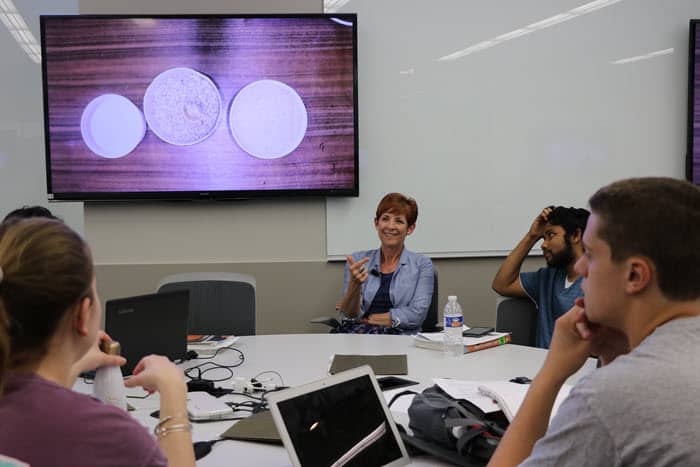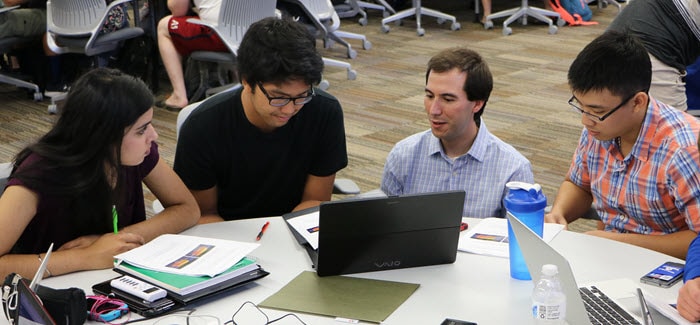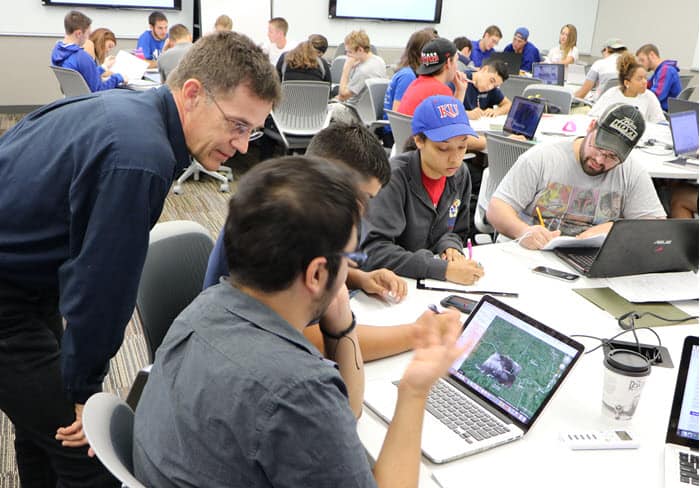Jennifer Roberts doesn’t hold back when describing her first attempt at active learning in a large lecture course.
“It was a train wreck,” said Roberts, a professor of geology who is now chair of the department. “It was bloody. Students were irate.”

This was in Geology 101, a required course for geology majors and one that typically draws a large number of engineering students. Starting in 2013, Roberts worked with a post-doctoral teaching fellow, Kelsey Bitting, to transform the class. They cut back on lecturing and devoted more time to group discussion and guided inquiry, with worksheets and in-class problem-solving. They introduced weekly reading quizzes and in-class questions to gauge understanding. They had students do more out-of-class writing. They also adopted two-stage exams and eliminated multiple-choice questions.
Essentially, she said in an interview in 2014, they made “this a class about the work students put into it and not necessarily about who had the old test that they memorized or just who was good at taking tests.”
Geology 101 is just one of hundreds of classes that have been transformed over the past few years as the university has emphasized the importance of retaining more students and helping them graduate. It illustrates, though, the hard work that has gone into raising retention and graduation rates at KU.
This fall, 86.2% of last year’s freshman class returned, compared with a low of 77.8% in 2008. That’s a phenomenal accomplishment made possible by the work of everyone from instructors like Roberts who have adopted more effective teaching practices to advisors who have helped students make better choices to administrators who have created new support programs and allocated money and resources to address a collective problem. These changes have helped shift the culture of teaching to one that emphasizes learning for all students.

Geology 101 also illustrates the importance of shared responsibility and community building in the success of students. For instance, Roberts’ remake of the course involved a teaching fellow, a second instructor, graduate teaching assistants and several undergraduate teaching assistants. The second instructor has been crucial for maintaining continuity because that person becomes the lead instructor in the ensuing semester. Noah McLean, Andreas Möller and Craig Marshall, among others, have been instrumental in maintaining that continuity and in continuing the evolution of Geology 101.
Having multiple instructors and teaching assistants in a classroom allows for group work, makes it easier for students to ask questions and get help with challenging course material, and makes large classes much more personal. New classrooms in the Earth, Energy and Environment Center and the LEEP2 engineering building have improved the atmosphere, too. The rooms in those buildings are in high demand, largely because their layout promotes interaction and makes large classes feel smaller than those in the stadium-style seating of Budig Hall.
McLean, an assistant professor of geology, said that the traditional layout for large classrooms intimidated many students and dissuaded them from asking questions. In active-learning classrooms, “you’re only looking at eight other people, and it’s much easier to bring students in and have a class-wide discussion,” McLean said.
‘Equity between men and women’
The series of changes made in Geology 101 has worked. Despite student complaints, more started getting C’s rather than D’s. Underrepresented minority students made substantial gains, with the number receiving D’s or F’s or withdrawing falling 5.6% between 2009 and 2016 even as more underrepresented students took the class.

More impressively, women in the class began performing significantly better in that same metric (a decline of 9.5%). Roberts said that women often accounted for 80% of the students who withdrew from the class or received D’s or F’s. In 2017, she said: “We now have equity between men and women.”
The work isn’t done, either in Geology 101 or in other classes across the university. In many ways, it has only begun, and we have a long way to go to achieve the type of widespread equity and achievement we hope to see. We should definitely celebrate, but we still have to keep pushing.
A year after remaking Geology 101, Roberts offered this reflection:
“The advice I have been giving the people who have started, especially in designing courses from scratch with this, is to make sure that they are choosing topics that they are really excited about because this can be a grind,” Roberts said. “And if you’re not really excited about going to class and sharing that information with the students, I don’t think you’re going to do it very well.”